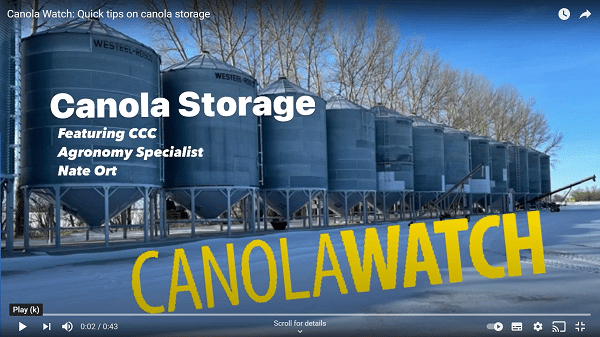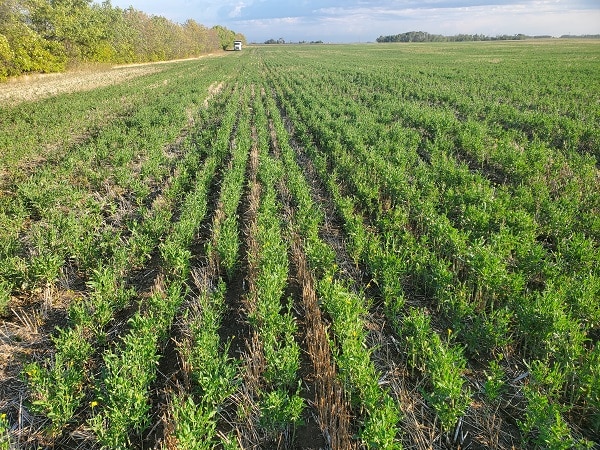

Green plants everywhere
Moisture brings growth and that includes regrowth of canola plants before and after harvest. What can you do about this regrowth?
Before harvest. Regrowth coming up through swaths will be a particular challenge because these can’t be sprayed. Harvest can be a slow process. Check sieves for build-up of green plant material (from green plants taken in with the swaths) and the harvest sample for green dockage. With green regrowth in a standing crop, a pre-harvest application of a diquat desiccant or Heat will dry-down that green and make harvest a little easier.
After harvest. Canola regrowth might as well be volunteer canola, except these plants have well-established root systems and will be harder to kill. Use higher rates of glyphosate and possibly a tank mix (especially if Roundup Ready) to stop the regrowing canola from taking up nutrients and water. See Fall weed control — Timing and targets for more information.
Other considerations. Green regrowth could be used as a “cover crop” to reduce soil erosion this fall and sequester carbon. It will also provide some plant material to capture more snowfall – especially useful if the harvested crop was too thin or cut too short to provide adequate stubble for snow catch. However, this cover crop will be taking up residual soil nutrients, which could be very high after 2021 (and soil water, which may be low). These resources will eventually be plant-available, but may not be there in time for 2022.
Fall weed management timing: Now or later?
Fall is a good time for weed management, especially for perennials and winter annuals. Good weed management in the fall has a few timing considerations. First, you want to wait four weeks after cutting for enough regrowth to take up herbicide. A big perennial with a large root system will have to take up a lot of herbicide, so if you spray too soon after cutting, there won’t be enough leaf area to take up the required amount of herbicide. The other question is, should you spray before or after a frost? If leaf area is minimal, wait until after weeds have recovered from frost. A frost may also trigger perennials to start moving energy down into their roots, which is the ideal situation to get lots of herbicide into the growing point.
Storage risks – sprouted seeds, green dockage
Sprouted seeds, small seeds and high levels of green dockage (from picking up regrowth, for example) are the more common storage risks this year. In all cases, turn on aeration to remove moisture and cool it down, and then monitor bins. Small seeds and high dockage can impede normal airflow, so move grain from one bin to another soon after storage — on a cool day — to remove hot spots and check again for seed moisture and potential spoilage. We heard reports of canola with high levels of green plant material starting to heat in the truck within a couple of days. We had a reader question about storage of sprouted seeds. Any type of physical damage to seed, including sprouting, will increase storage risk. Storing it dry will reduce the risk, but keep an eye on it until you sell it. As for sprouting getting worse in the bin, we don’t have any research on that. Assumption is “no” if canola moisture is 8% or less. For best management practices for using supplemental heating with natural air drying, check out this research. Key information on canola dockage is available here.
Setting the combine in variable fields
When you set the combine for a thin crop (narrow concave spacing, lower fan speed, high ground speed), combine efficiency can drop when the combine enters a thicker part of the field. The operator could slow to a crawl. Another option is to leave the heavy parts and do them separately after resetting the combine. Or, with two combines, run one in thin crop and the other in thick crop. (Of course this only works for standing crop.) The Combine Optimization Tool is an interactive source of the best combine-setting practices in most conditions. Further information on harvesting thin, low-yielding canola is available here. The online harvest loss calculator can help put a dollar value on loss.
